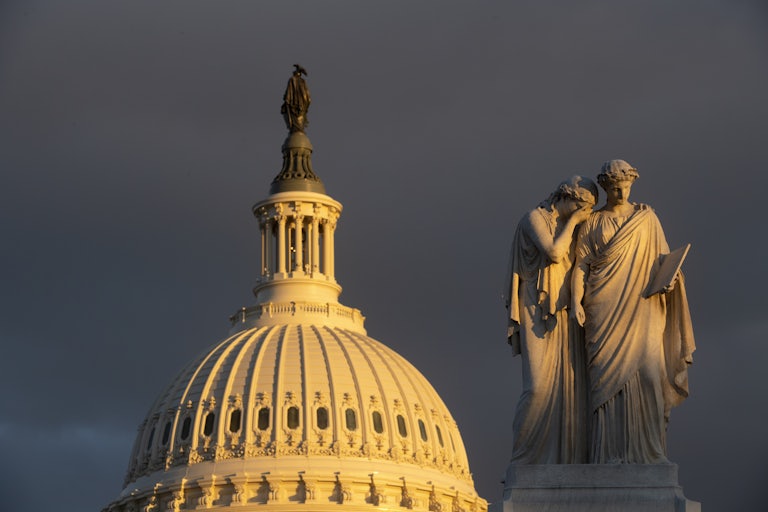Look Who’s Defying the Supreme Court Now
Republicans haven’t lost too often at the high court of late—but when they do, they’re sore losers indeed.

It goes without saying that Democrats don’t believe they’ve fared particularly well at the Supreme Court in recent years. This past term was no different, as the high court’s conservative majority ruled against affirmative action in higher education, sandbagged the Environmental Protection Agency, and struck down President Joe Biden’s plan to alleviate the burden of student loans. What’s interesting about these and other radical acts of the Roberts Court, though, is that Democrats have watched the political fallout redound to their benefit. That probably explains why liberals lately have been content to wage war with the court using political rhetoric or strategic policy work-arounds, allowing the public’s increasingly low esteem for the Supreme Court speak for itself.
But Roberts and his crew haven’t actually given Republicans everything they’ve wanted—or at least not everything to which they’ve felt entitled after spending so much money and effort to purchase the Supreme Court of their dreams. And the party that’s been getting the most cake from their comrades on the bench have proven, on those rare occasions where they’ve not prevailed, to be pretty sore losers. Now, as Garrett Epps at The Washington Monthly reports, they seem poised to do something radical about it.
At issue is Allen v. Milligan, a case which Matt Ford recently enthused as a rare instance in which the Roberts Court actually did something good on voting rights: a 5–4 ruling that the state of Alabama had to draw a second majority-Black congressional district. John Roberts and Brett Kavanaugh joined the liberal justices in declaring that Alabama had violated Section 2 of the Voting Rights Act of 1965. But the plaintiffs on the losing end of this case apparently plan to do something altogether different than the Democrats typically have on those numerous occasions when they’ve been hard done by the Supreme Court: They’re contemplating simply defying it.
This would be a very Alabama thing to do. As Epps recalls, former Governor George Wallace became the poster boy for defying the federal courts in 1963 when he “stood in the door of the University of Alabama six months later to block a federal court order that the university admit two Black students.” This is an interesting fact about the Supreme Court: They don’t actually have cops on hand who can go around ensuring compliance with their orders. Those familiar with the history of the high court might remember President Andrew Jackson’s semi-apocryphal response to the court’s decision in Worcester v. Georgia, one of the foundational rulings enforcing tribal sovereignty in the United States: “John Marshall has made his decision, now let him enforce it.”
This kind of open defiance of the court may not end up being necessary in the Alabama dispute, as Kavanaugh indicated that he’d be open to resolving the matter in a different way. But Epps notes that Republicans seem unusually keyed up to go to war with a Supreme Court that mostly just delivers everything they want, gift wrapped:
Let’s begin with the states; they are raring to go. Texas, for example, seems to regard Supreme Court decisions as mild suggestions. In 2021, its SB 8 abortion bill didn’t merely test the boundaries of Roe v. Wade but successfully negated it, even though the landmark 1973 ruling was affirmed by the Court as recently as 2016. The Court meekly allowed that bill to take effect. Months later, after the Court’s majority issued its opinion in Dobbs v. Jackson Women’s Health Organization and scrapped Roe, Texas Attorney General Ken Paxton invited state officials to begin prosecuting LGBTQ persons for “sodomy” and refusing same-sex marriage licenses (both forbidden by the Court). I am surely not the only one wondering what will happen if a federal court orders Governor Greg Abbott to remove the deadly pontoons he uses to block the Rio Grande.
I wonder how the political media will respond if Republicans revive the George Wallace/Andrew Jackson style of court opposition. Back in May, I observed that the rancid coverage of the debt ceiling crisis was emblematic of the asymmetrical way the media treats the two parties, where Republicans are “allowed to exert maximal power” to get what they want while Democrats are “forced into the role of helpmate, permitted to step up occasionally to buffer the GOP’s excesses but not to exert maximal power themselves.” It’s a fairly consistent pattern that puts Democrats in a bind while granting the GOP broad permission to test the limits of our norms and institutions.
So it’s not a great sign that The New York Times covered these goings on in Alabama with a piece headlined, “Alabama Lawmakers Decline to Create New Majority-Black Congressional District”—as if the court had merely offered a suggestion that could be opted out of instead of issuing a ruling. It is hard to believe that the same paper would have treated Biden as mildly if he had, say, refused to comply with the Supreme Court’s decision to scuttle his student loan relief plan. The political press seems overly vigilant about what Democrats might do in response to a wayward Supreme Court. (Even Epps is hard-pressed to deliver the examples of court defiance on the left that his piece promises.) During the last presidential campaign, they treated the mere notion that Biden might countenance court-packing as radical beyond words—this after largely treating the GOP’s refusal to grant Merrick Garland a hearing as the normal stuff of politics.
In any event, Democrats aren’t in any rush to impose those kinds of radical reforms on SCOTUS, and as TNR contributor Simon Lazarus explains, they have good reason: For the time being, the rhetorical and political campaigns they’ve waged against an unpopular court, coupled with some creative policy responses, have proven to be sufficient to mitigate some of the damage done. What’s more, liberals seem to be having an influence on the justices themselves: In Allen v. Milligan, Roberts was able to temper his previously well-documented hostility to the Voting Rights Act, which Lazarus chalks up to the fact that liberals have been highly effective politically of late, even as they’ve faced adversity from the court. Still, if that adversity ever gets to be too much, it will be worth remembering that the GOP has made it fair game to openly defy the court’s rulings.
This article first appeared in Power Mad, a weekly TNR newsletter authored by deputy editor Jason Linkins. Sign up here.









